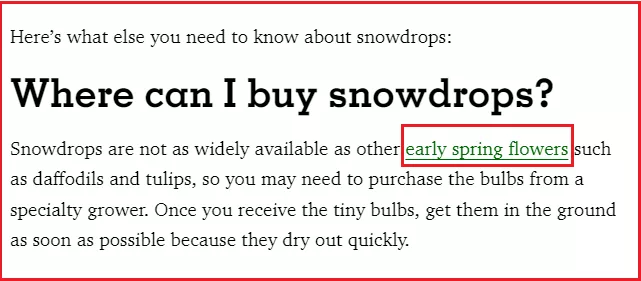What is Anchor Text?
Anchor text – aka link text and link label – is a visible, clickable and usually blue-coloured text in a hyperlink. This text is different from the surrounding text in appearance and is underlined.
Link text is mainly added to guide the searchers about a specific useful resource or topic.
Appropriate use of anchor text is the best way to get more clicks. It also makes the searchers stay more on your website by offering valuable information regarding a particular topic.
What does an anchor text look like?
Anchor text is the clickable text that is added to a page's content to connect one page to another.
Its colour is also changed, which makes it stand out from the rest of the text and makes the users click on it.
Not only the users but search engines also look at them and see if they are relevant to the content of the page or not.
On page content, it appears just like normal text but with a different colour. But on HTML, it looks like this:

How to add anchor text?
In HTML format, anchor text looks like this:
<a href=“https://seodebate.com/what -is-anchor-text/”>What is anchor text? </a>
To create this, locate the text where you want to add the anchor text. Now click “Edit Content” and then “HTML Editor Tab”.
In the HTML code, add the below code, and then press Save.
<a href="url">anchor text</a>Adding anchor text is quite simple for WordPress users.
Open the page and locate the text where you want to add the anchor text. Highlight the text. A pop-up will appear with a link icon.
Here you can add the link to the page you want to target. After that, your plain text will appear as an anchor text.
This process is almost the same for other CMS, i.e. Shopify and Wix.
Why is anchor text important?
Anchor text is important as it gives the idea to both visitors and search engines about the context or topic of the linked page.
Adding internal links to a website is also important for SEO as it makes your website structure well-organised. Google uses this text to understand the source and linked page's relevance and context.
Adding descriptive and relevant anchor text to these internal links makes it clear for the searchers and search engines to know what the linked page is about. It enhances user experience as well.
While adding anchor text to your pages, make sure to keep them relevant and descriptive. The text must correlate with the content of the page. It should not be generic like “Click here” or “Read more”.
Google has also mentioned on several occasions that the anchor text is a ranking signal and they use it to understand the content of the pages.
Using poor, irrelevant, or no anchor text is usually considered a bad SEO practice.
Types of anchor text
Here are the 7 most common types of anchor text.
Branded
In this case, the anchor text is the name of a brand.
For example
Seodebate
Exact match
This is the exact match of a targeted keyword or phrase.
For example
If a page is about “what is anchor text”, its anchor text will look like this:
What is anchor text?
Partial match
This means anchor text is partially matched with the main keyword.
For example
If the main or targeted keyword is “SEO services”, its anchor text looks like this:
SEO services in Dubai
It indicates the main keyword is partially present in anchor text along with “in Dubai” but not the exact phrase “SEO services” only.
Naked
This is also called “URL anchor text”. In this case, only the URL is added as an anchor text.
It looks raw and is usually not recommended because it is not helpful in most instances.
For example
https://www.seodebate.com/
Images
When an image is used in a link on a website, its alt text is used as an anchor text. This makes the images clickable.
For example

You must have seen clickable images on a website with a CTA that can be accessed by clicking on it.
Even if the images do not load, their anchor text is available and can be clicked. In HTML, the image anchors look like this:
<a href=”https://seodebate.com/what-is-anchor-text”> <img src=”/anchor-text.png” alt=”Anchor Text”/></a>Random or Generic
The anchor text is either generic or random - making it nonsensical and irrelevant to the context or topic of the page.
Usually, the searchers will have to read the text around this anchor text to learn what this anchor text is talking about.
For example
Read here, Learn more, Click here.
Related
The anchor text is not the exact match; instead, it is relevant to the topic. This type of anchor text is a great way to show your content's relevance and indicates that you have used it naturally.
For example
If the content of the main page is “Best search engine optimisation practices”, your related anchor text leading to other posts can be:
“anchor text optimisation strategies”, “link building methods”, or “guidelines to write quality content”.
All three topics are related to search engine optimisation practices.
How to optimise anchor text for SEO?
Here are a few ways to optimise your anchor text for SEO purposes.
Anchor text should be relevant
When adding anchor text to your content, make sure it is relevant.
It makes Google understand the structure of your website and what the linked page is about. Relevant links also make it easy for the readers to learn more about the topics that are related to the current topic.
Anchor text must specify to the users what kind of content they will get after landing on a page.
Keep in mind there should be no excessive repetition of keywords in anchor text as it looks spammy and will be considered a negative sign by Google.

In the example, you will see there is an anchor text that is pointing towards a page containing information about “early spring flowers”.
The page itself is about a flowering plant, “snowdrops”, so it makes sense to add a link to a relevant page. This is the best representation of relevant anchor text.
Do not over-optimise
An excess of everything is bad.
Though there is no set limit on the length of anchor text, keeping it short and descriptive will not make it look spammy. Moreover, avoid repeatedly adding the same anchor text on the same page.
Google takes keyword stuffing and over-optimized anchor text as negative factors. While optimising your anchor text, just see if it is actually making sense or providing a reason for the users to click on it.
Instead of just adding the exact match anchor text unnaturally, you must focus on creating valuable, meaningful, and relevant anchor text by keeping readers in mind.
Similarly, if you are using image anchor text, make sure to add descriptive alt text that clearly reflects your topic.
Avoid generic anchor text
Generic anchor text does not reflect the page's context or relevance to the surrounding text.
It is not only bad for searchers but also for search engines. It is, therefore good to avoid using generic anchor text like Read more, Click here, etc.
In short, an optimised anchor text is descriptive, relevant and precisely describes the page it is linking to.
How to find & fix anchor text issues?
Generally, you will not have any issues regarding anchor text nor will it harm your website.
A naked or generic anchor text may aggravate your visitors and can make Google not understand the topic or context of the linked page.
You can spot anchor text issues by using the SEMrush Site Audit Tool.
Go to Site Audit and enter your website. Once the audit is finished, enter the name of your project and click on the Issues tab.
Filter the results by typing Anchor. It will show you results with naked or generic anchor text.
Now you can open them one by one to see on which pages these errors exist. Fix them according to their nature and add meaningful and descriptive anchor text to the identified pages.
Is anchor text a Google ranking factor?
Anchor text is definitely a ranking factor.
Google wants to show the relevant results to the search queries of the searchers. That is why it encourages adding descriptive and relevant anchor text while avoiding over-optimizing it.
Google, on several occasions, has confirmed that they use anchor text to rank the pages for better visibility because it gives an idea of what the linked page is about.
While optimising sites for search engines, it is recommended to listen to Google – as it has already mentioned in its SEO starter guide what are the good and bad ways to optimise your link text.
…the better your anchor text is, the easier it is for users to navigate and for Google to understand what the page you're linking to is about”.
“With appropriate anchor text, users and search engines can easily understand what the linked pages contain.
During Webmaster Hangout, a web publisher also asked John Mueller about the impact of changing the anchor text of links.
Q: Does changing the text of older internal links to help users understand them have any downside? Can it hurt the rankings?
John Mueller answered:
No. That sounds perfect. If you’re updating anchor text internally to make it more easily understandable by users, then usually, that also helps search engines to better understand the context of those pages. So I would definitely go for that.
The bottom line
Anchor text is a great way to inform search engines and users about a particular link. It informs them whether this link is worth visiting or not.
Some people try to trick the system by over-optimizing their anchor text to increase their search engine visibility.
Google is quite efficient nowadays; it can now detect the content that is generated solely for the search engines rather than considering humans in mind.
Those days are long gone when adding exact match anchor text excessively ranked the websites for specific keywords.
Google also confirmed that they use anchor text to understand the meaning of linked pages, which helps them better display these pages in search results for relevant queries.
So without any doubt, anchor text is a ranking factor when used optimally and naturally.


